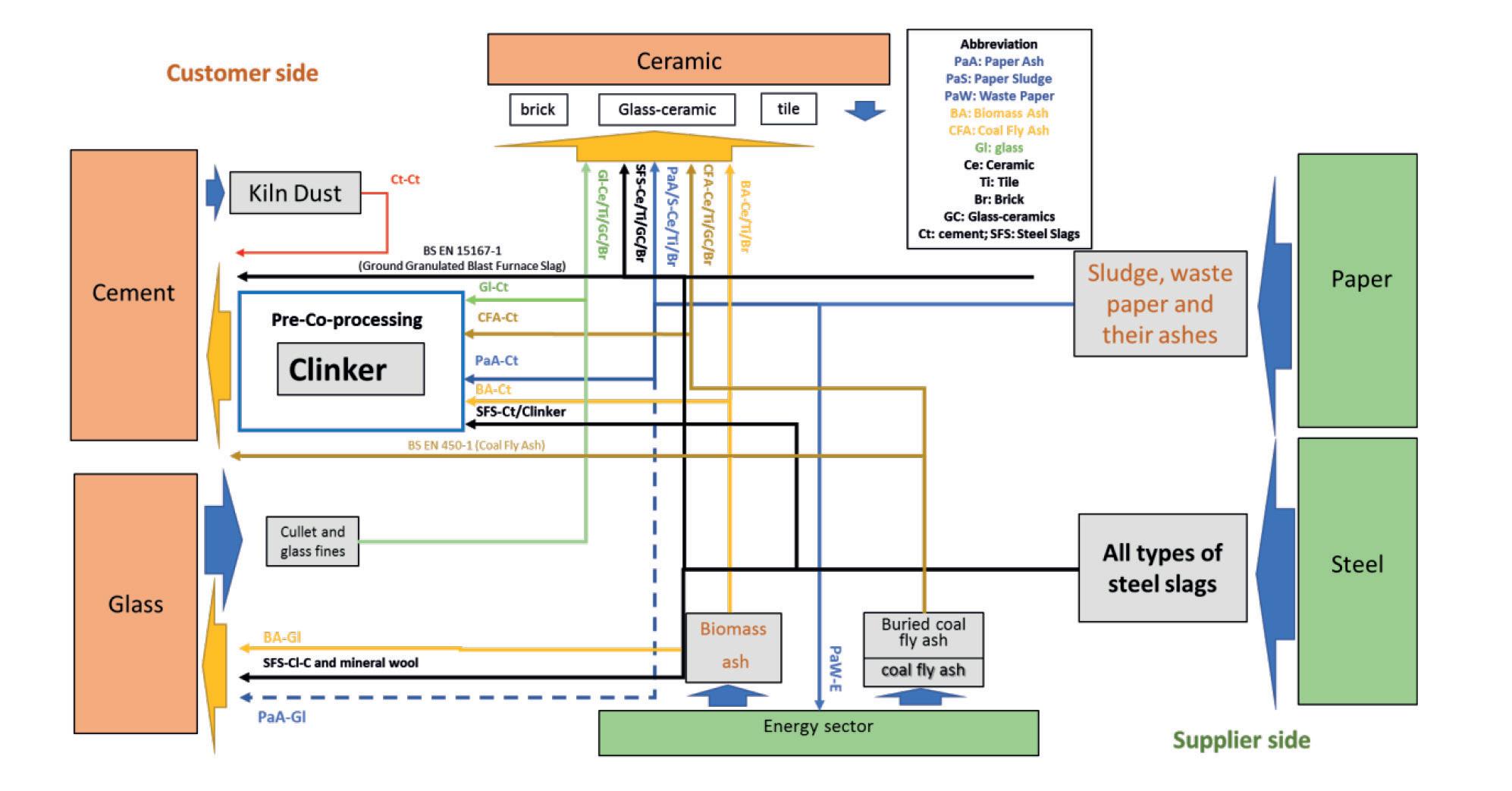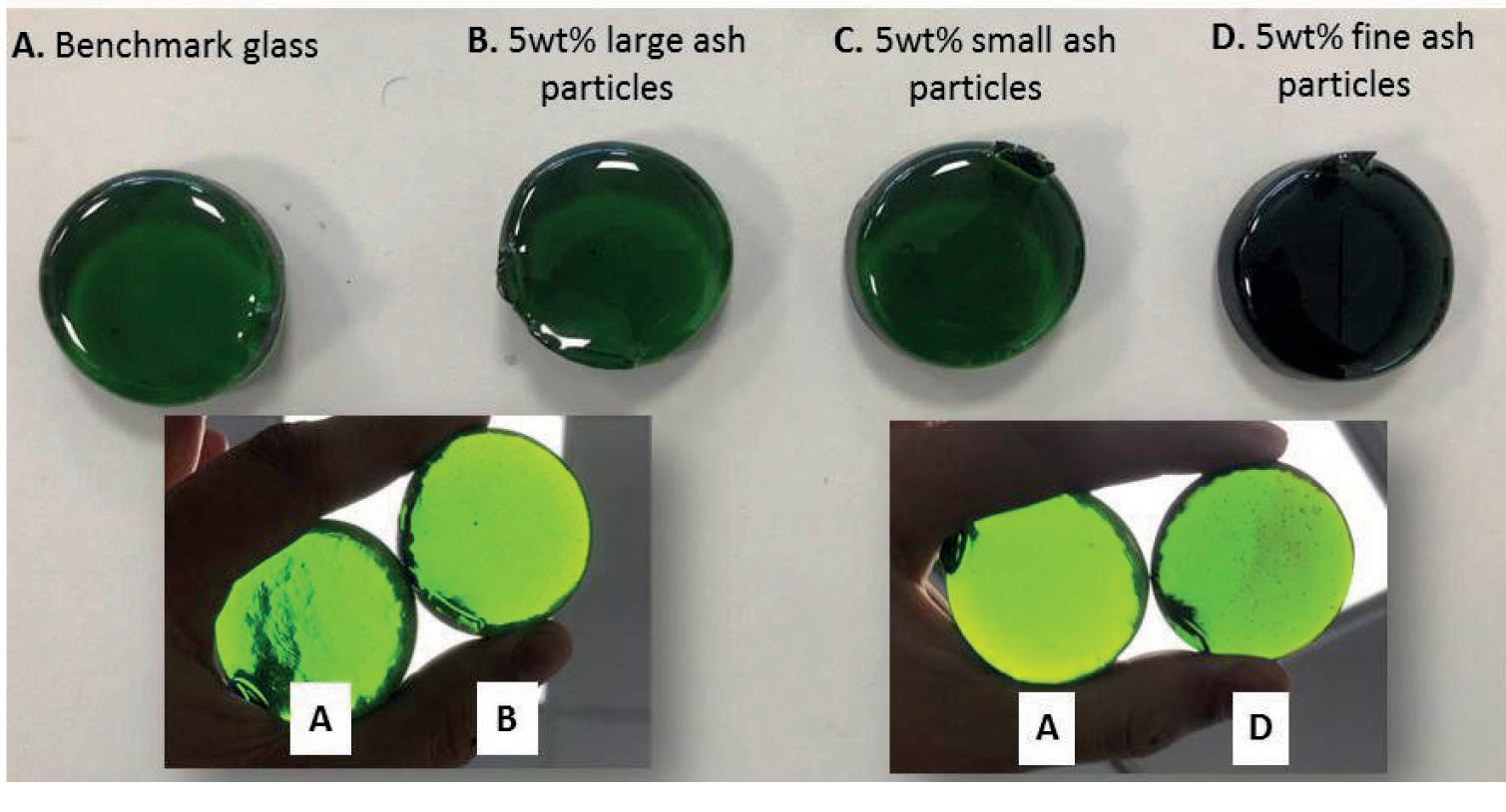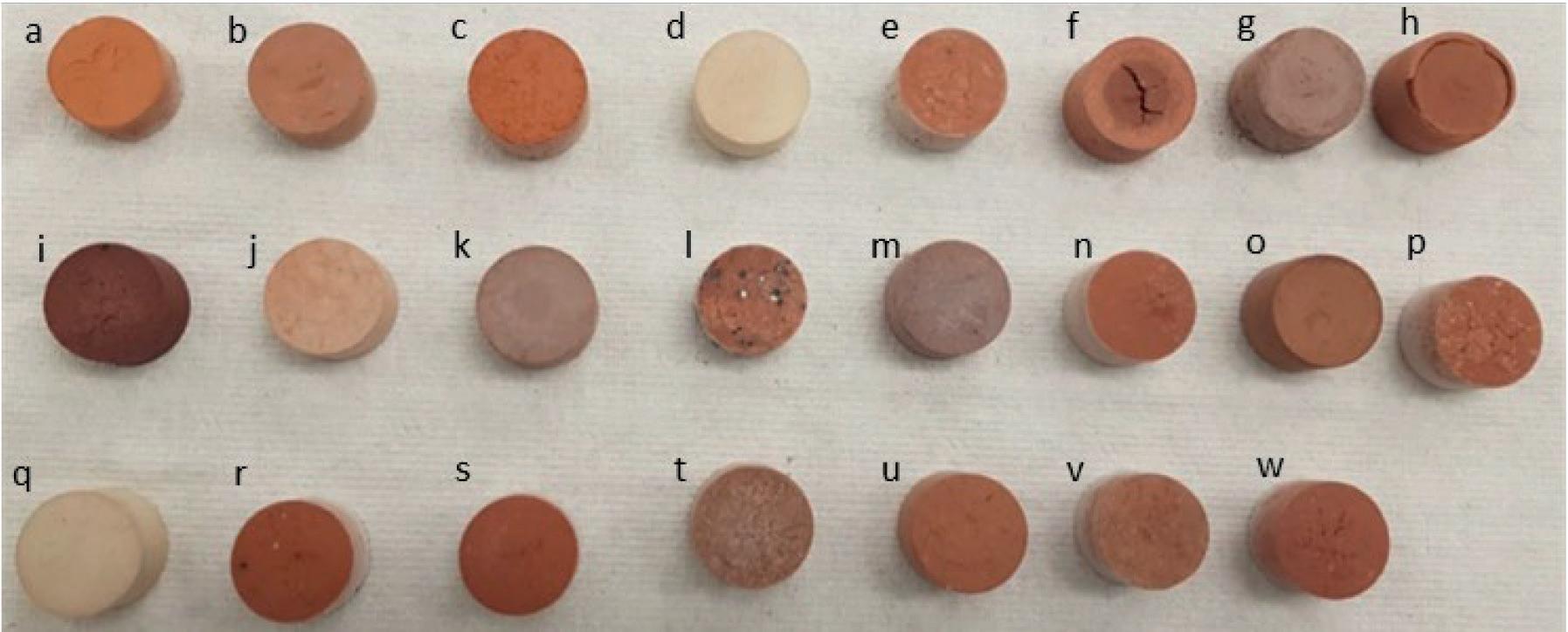
12 minute read
Alternative fuels
Paving the way to Net Zero by repurposing waste
R. Janani* , W. Deng*, D. J. Backhouse** , F. Kabir-Kazi*, G. Wie-Addo*, A. H. Jones*, C. M. Jackson*** , C. Holcroft**** , P. A. Bingham* discuss how wastes could be reused as valuable raw materials in glass and ceramic production processes and thus help reduce a manufacturer’s carbon footprint.
The 2015 Paris Agreement marked a key turning point in the global efforts against climate change.
More than five years into its endorsement, the UK government (in a joint effort with industry) has published multiple decarbonisation roadmaps1–6 outlining the challenges and potential pathways for various industrial sectors to minimise their emissions and energy consumption.
The UK’s Net Zero emission target by 2050 calls for urgent transformation of the six foundation industries (Fls: glass, ceramic, cement, paper, metal and bulk chemicals) valued at £52 billion/year7 .
These industries underpin UK supply chains by producing 75% of the overall fundamental materials for industrial sectors7. However, the FIs are energy- and resource- intensive and contribute significantly to UK CO2 emissions.
The CO2 emissions from the UK ceramics sector alone were estimated in 2012 to be 0.94 Mt/year, in addition to 0.28 Mt/year in electricity production for use within the sector1 .
In 2018, the UK concrete and cement sector contributed 1.5% of all UK CO2 emissions (>5.3 Mt)5 while in the same year the glass industry emitted >1.4 Mt of CO2 8. These numbers come as no surprise since the FIs heavily rely on fossil fuels. According to the reported UK 2019 statistics8, 3.5 Mt of glass is melted per year which translates to 6 TWh of natural gas and 1 TWh of electricity consumption. The energy costs for the glass industry are estimated to be around £240 million/year.
Reduction in production costs has been a key driving force for these sectors to move towards a carbon-neutral energy strategy, even prior to the emission reduction legislations.
Considerable improvements in the energy efficiency of furnaces (≈50%) in the glass sector over the past 40 years8 and a 27% reduction in carbon intensity of the cement sector since 19905 are
Continued>>
� Fig 1. Proposed supply chain map illustrating potential waste-streams from FIs and energy sectors to the glass, ceramic and cement industries.

Fig 2. Optical images of green container glasses produced with and without additional 5wt% � (washed) plant-based biomass ash with a particle size ranging from large to fine.
some of the outcomes of these efforts. However, there remains a range of transformations to existing infrastructure and manufacturing processes that must be achieved in order to help meet the decarbonisation objectives.
During the Glasgow Climate Change Conference (COP26) in November 2021, parties reached an agreement to ‘phasedown’ unabated coal power and to ‘phase-out’ inefficient fossil fuel subsidies in order to transition to low-transmission energy sources9. Recently, British Glass set out its Net Zero by 2050 strategy8 to complement the 2014 and 2015 glass sector decarbonisation roadmaps6,10 .
These documents highlighted that reduction in combustion emissions, process emissions and expansion of the circular economy are key strategies to enable incremental improvements of the glass industry (as well as other FIs) towards zero emission.
Encirc’s objective to utilise hydrogen to melt glass by 2025, with the support of the HyNet scheme, is an example of a step-change towards zero CO2 emissions in the glass industry11. Nonetheless, any opportunity to make improvements (however major or incremental) to the process emissions or circular economy within FIs should not be overlooked.
Carbonates used as raw materials in the FIs are another key contributor to the overall CO2 emissions, making up 1025% of emissions from the glass sector8 and 70% from the cement sector3 .
Sourcing reliable alternative raw materials that can not only replace the carbonates but also reduce processing energy requirements while remaining financially viable is a great challenge.
The EnviroAsh project aimed to overcome this challenge by identifying routes to convert and optimise wastestreams from across FIs and energy sectors (e.g. waste ashes) into new raw materials. This would allow converting disposal costs into opportunities for income generation whilst helping to reduce environmental impact.
This project expands upon an established consortium, with a proven track record of developing raw materials from wastes within the UKRI-funded EnviroGlass 2 project (reference no. 104382) and the BEIS-funded BiomAsh project (Glass Technology Services, Sheffield Hallam University, Power Minerals, Glassworks Services), introducing new partners from the glass industry and other FIs (Encirc, Glass Futures, Hanson, Wienerberger, Saica, Drax and University of Sheffield) to expand the range of wastes to be investigated and final products that can benefit from these materials.
Whilst this is a new and focused approach, utilising waste products such as ash as raw materials in the manufacture of glasses, ceramics and cement is nothing new!
For example, the incorporation of ashes in ceramic manufacture in China dates back to 1500 BC in the Shang period when unexpected yellowish-green glaze began to appear on wood-fired ceramics.
Lime-rich wood ashes in the hightemperature kilns are believed to have reacted with the surface of the clay body resulting in the thin yellowish glaze12. The wood ash glazing technology gradually developed and became widespread towards the end of the Shang period and the beginning of Zhou dynasty. Ceramics from this period are known as protoporcelain. Similarly, it is believed that halophytic plant ashes (rich in sodium salts) were used as the alkali source for the earliest glasses until 800 BC13 .
They were predominantly replaced by natron during the Hellenistic and Roman Empires and Sasanian dynasty.
Unreliable supplies of natron glass necessitated plant ashes (primarily wood ash) to become the primary alkali for glass made in northern Europe from 800 AD and continue to be utilised until the 17th Century. Wood ash glasses, also known as forest glasses, manufactured during this period in Central Europe can be differentiated by their CaO/K2O content which is associated with the composition of the wood and the proportion of twig (bark content)14 .
Today and to a lesser extent, plant ashes are still used for glass and ceramic glazing. Application of other types of ashes such as coal-combustion fly ashes has been explored and utilised in the production of construction ceramics with positive results15,16. Utilisation of certain ashes as the pozzolanic admixture (e.g. rice husk ash) is currently being investigated in cement and concrete production17, while fly ashes are already being used as partial replacement for cement in concrete (High Volume Fly Ash Concrete18).
Despite their historical use, the utilisation of waste ashes as raw materials in FIs is yet to meet its full potential. Variations in chemical and physical composition of the waste ashes (and other waste products more widely), consistency of supply, presence of undesirable compounds and lack of industrial-scale proof of concepts are some of the barriers that require addressing.
Based on the available literature and the experience within the EnviroAsh consortium, a waste supply chain map (Fig 1) was generated to help identify potential waste sources (from FIs and energy sectors) as raw material for different products across the glass, ceramics and cement sectors. This is a great step towards optimising the flow of resources within and in between FIs.
The transition from waste to ready-touse raw material may require treatment and / or sorting procedures. The presence of problematic elements such as Cl and S

� Fig 3. Optical image of ceramic samples showing a representative heavy clay ceramic sample (a) and those produced by incorporating 22 different types of waste ashes into the heavy clay at 20wt% (b-w).
and other undesirable compounds such as heavy metals and organic residues can limit the application of waste products in some FIs, although the specific requirements can differ between glass, ceramics and cement applications.
During the span of the EnviroAsh project, a variety of different techniques was examined in an attempt to sort and purify the waste materials.
Magnetic separation (wet, dry, and electrostatic), air density and specific gravity separation as well as ash washing are examples of the techniques explored, some with promising results.
Examples of green container glasses produced with the addition of washed waste plant ashes are presented in Fig 2. The overall comparability of the ash-containing glass samples with the benchmark glass is encouraging.
The amber shade in the glass sample made with the finer ash particles (D) is due to the presence of higher levels of carbon-bearing compounds.
Therefore, identifying the appropriate treatment(s) required for each waste material (for this example, a separation technique such as sieving) enables control over the physical and chemical properties of the final product.
Given the compositional diversity of waste materials, careful consideration of the end-product properties is crucial when it comes to selection of the waste.
Under the umbrella of the EnviroAsh project, the feasibility of waste materials for application in glass, ceramic and cement products were examined.
For instance, over 20 types of ashes (including plant ashes) were incorporated in heavy clay at 10-20wt% for the production of ceramics (Fig 3).
Apart from changes to the colour of the product against the benchmark sample (which can in some cases be desirable), improvements in compressive strength19 and variations in other properties such as porosity and pore size distribution20,21 can confer benefits to the end-user.
While industrial trials are currently under discussion, the work carried out during this project will feed into current activities being undertaken by the EPSRC TransFIRe and TFI Network+ projects to help FIs face the challenges set out by environmental legislation and meet the CO2 reduction commitments enshrined in UK law. Actions taken today by the industry and all of us across the UK will directly support delivery of UK Net Zero emission commitments by 2050. �
*Materials and Engineering Research Institute, Sheffield Hallam University, UK. **Glass Futures, Sheffield, UK ***Department of Archaeology, University of Sheffield, UK ****Glass Technology Services, Sheffield, UK
Acknowledgements
The authors would like to thank the project partners at Glass Technology Services, University of Sheffield, Power Minerals, Glass Futures, Glassworks Services, Encirc, Saica Paper UK, Drax Group, Wienerberger and Castle Cement (Hanson). The EnviroAsh project was funded by Innovate UK as part of the Transforming Foundation Industries: Fast Start Projects funding call (reference no. 49096) and the authors acknowledge, with thanks, Innovate UK for this funding.
References
1. WSP Parson Brinkerhoff, DNV GL. Industrial Decarbonisation & Energy Efficiency Roadmaps to 2050: Ceramic Sector.; 2015. https://assets.publishing. service.gov.uk/government/uploads/ system/uploads/attachment_data/ file/416676/Ceramic_Report.pdf 2. WSP Parson Brinkerhoff and DNV GL. Industrial Decarbonisation & Energy Efficiency Roadmaps to 2050: Cross Sector Summary, Glass, Cement and Pulp and Paper Reports.; 2015. https://www.gov. uk/government/publications/industrialdecarbonisation-and-energy-efficiencyroadmaps-to-2050 3. Department for Business Energy and Industrial Strategy and MPA UK Concrete. Industrial Decarbonisation and Energy Efficiency Roadmap - Action Plan: Cement Sector.; 2017. https://assets. publishing.service.gov.uk/government/ uploads/system/uploads/attachment_data/ file/651222/cement-decarbonisationaction-plan.pdf 4. Department for Business Energy and Industrial Strategy and British Ceramic Confedaration. Industrial Decarbonisation and Energy Efficiency Roadmap Action Plan: Ceramic Sector.; 2017. 5. MPA UK concrete. UK Concrete and Cement Industry Roadmap to Beyond Net Zero.; 2020. https://thisisukconcrete. co.uk/TIC/media/root/Perspectives/MPAUKC-Roadmap-to-Beyond-Net-Zero_ October-2020.pdfhttps://thisisukconcrete. co.uk/TIC/media/root/Perspectives/ MPA-UKC-Roadmap-to-Beyond-Net-Zero_
October-2020.pdf 6. GL WPB and D. Industrial Decarbonisation & Energy Efficiency Roadmaps to 2050: Glass.; 2015. https:// assets.publishing.service.gov.uk/ government/uploads/system/uploads/ attachment_data/file/416675/Glass_Report. pdf 7. Cranfield to lead foundation industries green recovery research consortium. Cranfield University. Published 2021. https:// www.cranfield.ac.uk/press/news-2021/ cranfield-to-lead-foundation-industriesgreen-recovery-research-consortium 8. British Glass. Glass Sector Net Zero Strategy.; 2021. https://www.britglass. org.uk/knowledge-base/resources-andpublications/glass-sector-net-zerostrategy-2050 9. COP.26 Glasgow Climate Pact Adaptation Finance - Decision (Advance Unedited Version). https://unfccc.int/sites/ default/files/resource/cop26_auv_2f_cover_ decision.pdf 10. British Glass Manufacturer’s Confederation. A Clear Future. UK Glass Manufacturing Sector Decarbonisation Roadmap to 2050 Summary.; 2014. https:// www.britglass.org.uk/sites/default/files/A clear future - UK glass manufacturing sector decarbonisation roadmap to 2050_ summary.pdf 11. North West Selected for Hydrogen Revolution Following Government Decision. https://www.encirc360.com/2021/11/02/ north-west-selected-for-hydrogenrevolution-following-government-decision/ 12. Yin M, Rehren T, Zheng J. The earliest high-fired glazed ceramics in China: The composition of the proto-porcelain from Zhejiang during the Shang and Zhou periods (c. 1700-221 BC). J Archaeol Sci. 2011;38(9):2352-2365. doi:10.1016/j. jas.2011.04.014 13. Henderson J. Ways to Flux Silica. In: Ancient Glass: An Interdiciplinary Exploration. ; 2013:22-55. doi:10.1017/ cbo9781139021883.003 14. Wedepohl KH, Simon K. The chemical composition of medieval wood ash glass from Central Europe. Geochemistry. 2010;70(1):89-97. doi:https://doi. org/10.1016/j.chemer.2009.12.006 15. Lingling X, Wei G, Tao W, Nanru Y. Study on fired bricks with replacing clay by fly ash in high volume ratio. Constr Build Mater. 2005;19(3):243-247. doi:https://doi. org/10.1016/j.conbuildmat.2004.05.017 16. Húlan T, Štubna I, Ondruška J, Trník A. The influence of fly ash on mechanical properties of clay-based ceramics. Minerals. 2020;10(10):1-12. doi:10.3390/min10100930 17. Bapat JD. Mineral Admixtures in Cement and Concrete. Taylor and Francis Group; 2012. doi:10.1201/b12673 18. Herath C, Gunasekara C, Law DW, Setunge S. Performance of high volume fly ash concrete incorporating additives: A systematic literature review. Constr Build Mater. 2020;258:120606. doi:https://doi. org/10.1016/j.conbuildmat.2020.120606 19. Smith A. To demonstrate commercial viability of incorporating ground glass in bricks with reduced emissions and energy savings, 2004;(March):0-35. 20. Cultrone G, Sebastián E. Fly ash addition in clayey materials to improve the quality of solid bricks. Constr Build Mater. 2009;23(2):1178-1184. doi:10.1016/j. conbuildmat.2008.07.001 21. Eliche-Quesada D, Sandalio-Pérez JA, Martínez-Martínez S, Pérez-Villarejo L, Sánchez-Soto PJ. Investigation of use of coal fly ash in eco-friendly construction materials: fired clay bricks and silica-calcareous non fired bricks. Ceram Int. 2018;44(4):44004412. doi:10.1016/j.ceramint.2017.12.039


11-12 MAY
Monterrey, Mexico
GLASSMAN LATIN AMERICA RETURNS TO MEXICO
Glassman events are where the hollow glass industry does business. Join us in Mexico to meet thousands of buyers looking for innovative manufacturing solutions for energy effi ciency, quality control, packaging, logistics and decoration.
Contact the team below to book a stand in Mexico.
INTERNATIONAL EXHIBITION
2-DAY CONFERENCE
NETWORKING EVENTS
GET INVOLVED

To view the latest floor plan and to fi nd out who is already exhibiting contact our sales team
EXHIBIT Ken Clark
Sales Director +44 (0)1737 855117 kenclark@quartzltd.com
EXHIBIT Manuel Martin Quereda
International Sales Executive +44 (0)1737 855023 manuelm@quartzltd.com
SPEAK Greg Morris
Editor
gregmorris@quartzltd.com
ATTEND Hannah Blake
Marketing Manager +44 (0)1737 855022 hannahblake@quartzltd.com
www.GlassmanEvents.com/Latin-America
Join the Glassman Group @glassmanevents
Organised by:
BUSINESS MEDIA Offi cial media partner: COMING SOON...
GLASS INTERNATIONAL COMMEMORATIVE BOOK
This commemorative book is a celebration of the International Year of Glass which will highlight the important role that glass plays in the 21st century and beyond.
PUBLISHING MARCH 2022
FIND OUT MORE
KEN CLARK Sales Director +44 (0)1737 855117 kenclark@quartzltd.com MANUEL MARTIN QUEREDA International Sales Executive +44 (0)1737 855023 manuelm@quartzltd.com
GLASS-INTERNATIONAL.COM










